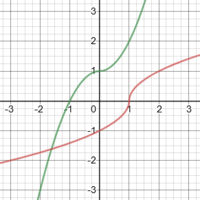[MATH]f(x) = x \mid x \mid +1[/MATH], is the following function bijective, if so, what´s the inverse? Note, you must also state the domain and range of the inverse and the function.
\begin{equation*}
\lvert x \rvert = \left\{
\begin{array}{ll}
-x & \quad x \leq 0 \\
x & \quad x \geq 0
\end{array}
\right.
\end{equation*}
[MATH]g(x)=x^2+1, x \geq 0 [/MATH][MATH]h(x)=-x^2+1, x \leq 0[/MATH]
[MATH]h^-1(x)=\pm \sqrt{x-1}, x\geq 1[/MATH][MATH]g^-1(x)=\pm \sqrt{1-x}, x\leq 1[/MATH]
Is this correct so far or am I going in the wrong direction? I have a hard time knowing which sign I should choose for my inverses, are there any "tricks" to knowing?
\begin{equation*}
\lvert x \rvert = \left\{
\begin{array}{ll}
-x & \quad x \leq 0 \\
x & \quad x \geq 0
\end{array}
\right.
\end{equation*}
[MATH]g(x)=x^2+1, x \geq 0 [/MATH][MATH]h(x)=-x^2+1, x \leq 0[/MATH]
[MATH]h^-1(x)=\pm \sqrt{x-1}, x\geq 1[/MATH][MATH]g^-1(x)=\pm \sqrt{1-x}, x\leq 1[/MATH]
Is this correct so far or am I going in the wrong direction? I have a hard time knowing which sign I should choose for my inverses, are there any "tricks" to knowing?

